Fattorini H.O., Kerber A. The Cauchy Problem
Подождите немного. Документ загружается.

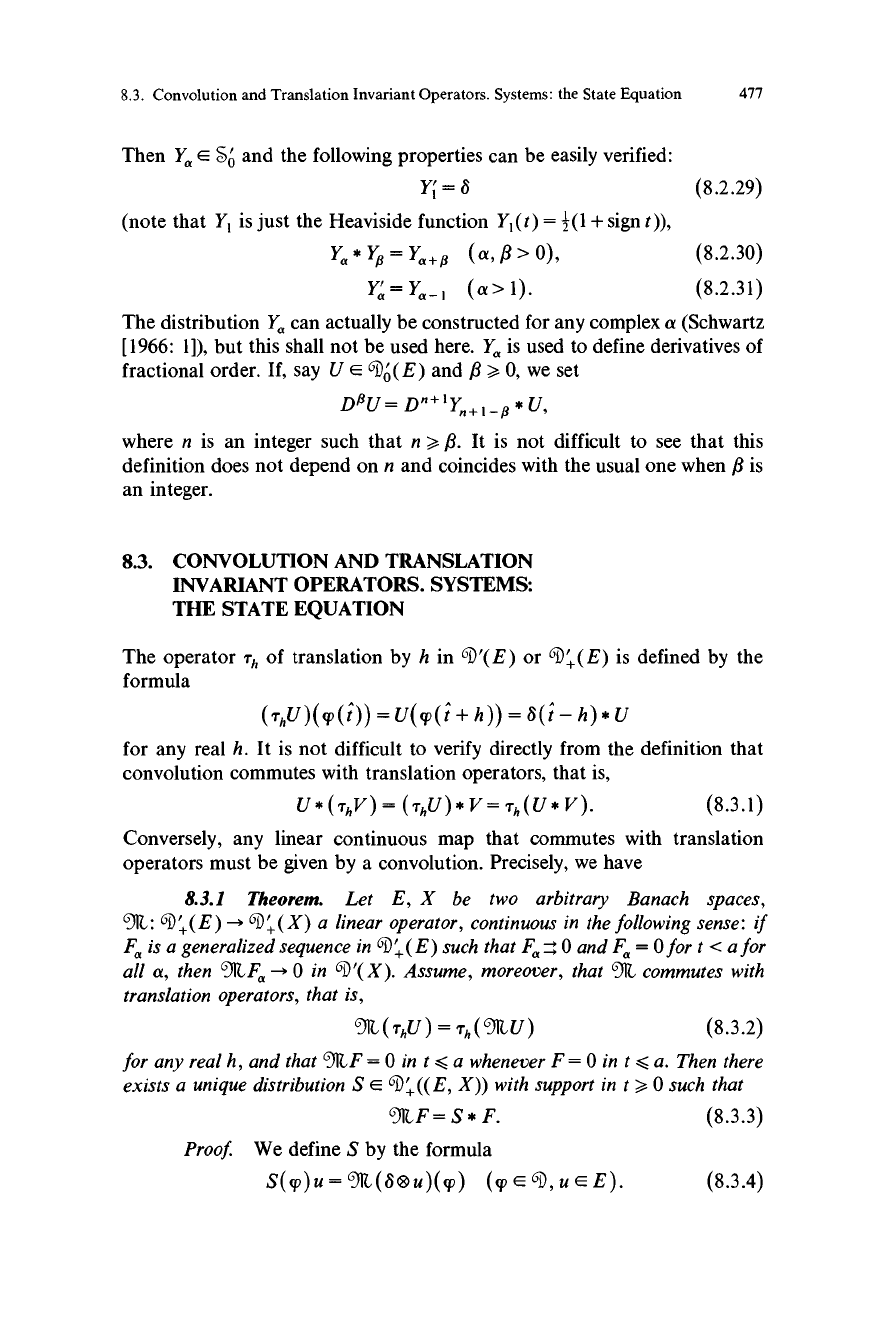
8.3. Convolution and Translation Invariant Operators. Systems: the State Equation
477
Then Ya E 5' and the following properties can be easily verified:
Yi=S (8.2.29)
(note that Y, is just the Heaviside function Y, (t) = -2L(1 + sign t)),
Ya*Y,8=Ya+p (a,Q>0),
(8.2.30)
Y.I=Ya_, (a>l).
(8.2.31)
The distribution Ya can actually be constructed for any complex a (Schwartz
[1966: 1]), but this shall not be used here. Ya is used to define derivatives of
fractional order. If, say U E 6D (E) and $ >, 0, we set
D#U=Dn+'"+I
_
* U,
where n is an integer such that n >, Q. It is not difficult to see that this
definition does not depend on n and coincides with the usual one when Q is
an integer.
8.3. CONVOLUTION AND TRANSLATION
INVARIANT OPERATORS. SYSTEMS:
THE STATE EQUATION
The operator Th of translation by h in 6D'(E) or 6 +(E) is defined by the
formula
(ThU)(T(i)) = U(T(i+ h)) = 8(t- h) * U
for any real h. It is not difficult to verify directly from the definition that
convolution commutes with translation operators, that is,
U*(ThV)=(ThU)*V=Th(U*V).
(8.3.1)
Conversely, any linear continuous map that commutes with translation
operators must be given by a convolution. Precisely, we have
8.3.1
Theorem. Let E, X be two arbitrary Banach
spaces,
OJlt: c +(E) - 6+(X) a linear operator, continuous in the following sense: if
Fa is a generalized sequence in 6 +(E) such that Fa -0 and Fa = 0 for t < a for
all a, then 6XFa - 0 in 6D'(X). Assume, moreover, that 6J1t commutes with
translation operators, that is,
Olt(ThU) = Th(GJii,U) (8.3.2)
for any real h, and that O ltF = 0 in t < a whenever F = 0 in t < a. Then there
exists a unique distribution S E 6+((E, X)) with support in t > 0 such that
9XF = S * F.
(8.3.3)
Proof. We define S by the formula
S(p)u=GJ1t(S(&u)((7)
(gpE6 ,uEE).
(8.3.4)

478
The Cauchy Problem in the Sense of Vector-Valued Distributions
For any fixed T, S(q)) is a linear operator from E into X. Continuity (or
boundedness) of S((p) follows from the fact that if is a sequence in E
converging to zero, then 8 ® u ; 0 in 6 '(E ), whereas 8 ® u = 0 for t < 0;
hence IJlt (So 0 in 6D'(X), and then so does S(qq) u in X. Since the
map qp -* S(T) E (E, X) is linear, in order to show that S E 6D'((E, F)), we
only have to prove that S(p) - 0 whenever cp - 0, { T } a sequence in 6D.
In order to do this, we need some more information on the topology of
distribution spaces. Let E be, for the moment, an arbitrary Banach space, St
an open interval in R.
8.3.2
Lemma.
Let 5 c 6D'(2; E) be a bounded set, and let
be a
sequence converging to zero in 6 (SZ). Then
uniformly for F in q.
Proof
By virtue of Lemma 8.1.9, we know that given a compact
subset K of St, there exists an integer p >, 0 and a constant C such that
IIF((p)fl <Cllrollp
(FE=-X)
(8.3.5)
for any T E 6D with supp(g)) c K, where
is the semi-norm defined in
(8.1.13). In view of the definition of convergence in 6D, Lemma 8.3.2 follows.
End o f p r o o f o f Theorem 8.3.1.
Consider the set ° ? L = (8 ®u; l u l l < 1)
C 6D '(E ). Direct application of the definition shows that Qt is bounded.
Then X t' = 6Jlr, (QL ), being the image of a bounded set through the operator
GJ1t, must be as well bounded. According to Lemma 8.3.2, 9X (8 0 u)(%) =
S(q)n) u tends to zero uniformly for I
I u I I < 1, which shows that S : 6D - (E, X)
is a continuous operator, that is, S E 6D'((E, X)). It results from the
definition of S and from the hypotheses that S = 0 in t < 0, so that to
complete the proof of Theorem 8.3.1, we only have to show (8.3.3). In order
to do this we begin by observing that Olt commutes with differentiation, that
is,
(%F)(m)=CXF(m)
(8.3.6)
for any integer m >, 0. This results for m =1 observing that if F E 61 +(E ),
- h - t (Th F - F) -_ F in 6D'(E) and for m > 1 by induction. We note next
that we only need to verify (8.3.3) "locally," that is, in all intervals (- oo, c),
c > 0. Making then use of Theorem 8.1.5 we conclude that it is only
necessary to show that (8.3.3) holds when f is a continuous function with
values in E whose support is bounded below. Let then c > 0, m a nonnega-
tive integer, and g a continuous function with values in (E, X) such that
S = g(m) in t < c
(8.3.7)
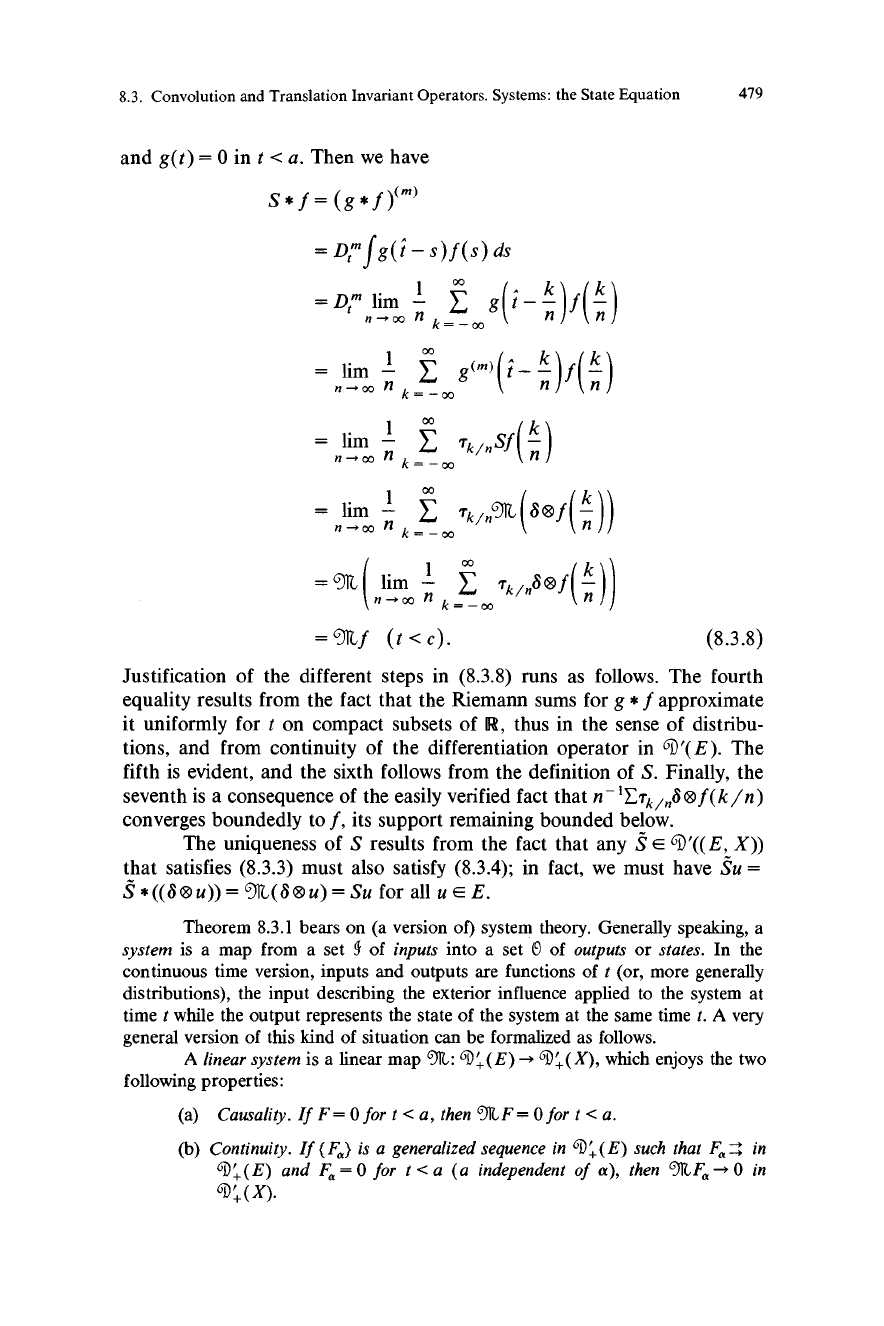
8.3. Convolution and Translation Invariant Operators. Systems: the State Equation
479
and g(t) = 0 in t < a. Then we have
S*f=(g*f)(m)
=D1m f g(t-s)f(s)ds
= Dim lim 1
n -. 00 n
`t
n)(n)
k =oo g
f
1 00
nl-oo n k
ooglml\t
n)f(n)
00
nlioo
n
E Tk/nsf (n )
k= - oo
nli
n
L,
Tk/n'1'
(s
®f
(-n))
k= - oo
00
_ 1DX
llm - Tk/ns®
)
n
oo n k=- oo
fn)
(
=Oltf (t<c).
(8.3.8)
Justification of the different steps in (8.3.8) runs as follows. The fourth
equality results from the fact that the Riemann sums for g * f approximate
it uniformly for t on compact subsets of R, thus in the sense of distribu-
tions, and from continuity of the differentiation operator in 6 '(E ). The
fifth is evident, and the sixth follows from the definition of S. Finally, the
seventh is a consequence of the easily verified fact that n-'ETk/nS®f(k/n)
converges boundedly to f, its support remaining bounded below.
The uniqueness of S results from the fact that any S E 6 '((E, X))
that satisfies (8.3.3) must also satisfy (8.3.4); in fact, we must have Su =
S*((S®u))=')1t(S®u)=Su for all uEE.
Theorem 8.3.1 bears on (a version of) system theory. Generally speaking, a
system is a map from a set I of inputs into a set 0 of outputs or states. In the
continuous time version, inputs and outputs are functions of t (or, more generally
distributions), the input describing the exterior influence applied to the system at
time t while the output represents the state of the system at the same time t. A very
general version of this kind of situation can be formalized as follows.
A linear system is a linear map 'A: 6 +(E) - 6 +(X), which enjoys the two
following properties:
(a)
Causality. If F= 0 for t < a, then GJltF= 0 for t < a.
(b) Continuity. If (F,,) is a generalized sequence in 6D ' (E) such that F.' in
6 ' (E) and F. = 0 for t < a (a independent of a), then 1AF, -> 0 in
6+(X).

480
The Cauchy Problem in the Sense of Vector-Valued Distributions
Condition (a)
is rather natural in that it simply prescribes that cause
precedes effect; in other words, the output 1.YLF cannot make itself felt before the
input F that originates it begins to act. That some continuity condition like (b) must
be imposed it is obvious, if only on mathematical grounds; in fact, if inputs that
differ by little could produce outputs that he wide apart, the usefulness of our
system as a model for a physical situation would be small, since any kind of
prediction based on the model would be impossible (or, at least, extremely sensible
to observation errors.) However, it
is not necessarily true that the notion of
continuity that we are using is the adequate one in each application. The same
comment can be made about the choice of input and output spaces; while to use
distributions as inputs seems to be natural in view of, say, the interpretation of
8(t- to)®u as an "impulsive excitation" at time to, so useful in applications, it is
not necessarily true, however, that distributional outputs will have any physical
interpretation.
Leaving aside the question of motivation we go back now to the linear
system RJR,: 6l +(E) - 6+(X). We call the system time-invariant if fit, commutes
with translation operators, that is, if (8.3.2) holds for all h. Roughly speaking, this
means that "the result of the experiment does not depend on the starting time" or,
that "the system itself does not change in time." It follows from Theorem 8.3.1 that
there exists in this case a unique S E 6 D'((E, X)) with support in t > 0 such that
U=%F=S*F (FE6 +(E)).
(8.3.9)
We call S the Green distribution of the system. Observe that, since Su = 91L( 8 0 u),
the distribution S can be computed "experimentally" by feeding inputs of the form
80 u to the system and observing the corresponding outputs.
We call the system invertible if
)t = X-': 6D+(X) -> 6l +(E) exists and is
continuous in the same sense as OiL, and 9LU = 0 in t < a whenever U = 0 in t < a.
It follows from Theorem 8.3.1 that there exists a distribution P E 6 '((X; E)) with
support in t > 0 that relates input and output through the equation
P*U=F (UE6i+(X)).
(8.3.10)
We call (8.3.7) the state equation of the system. It is immediate that P is the
convolution inverse of S; in other words,
P*S=S®I, S*P=S®J,
(8.3.11)
where I is the identity operator in E, J the identity operator in X. In practice, it is
usually the state equation that is given, and our task is to reconstruct the system OJiL
from it, which of course amounts to finding the Green distribution S by solving the
equations (8.3.11), that is, finding a convolution inverse of P with support in
t>0.
We deal in the sequel with an invertible system. Up to now we have
exclusively considered the case where the system is initially at rest (which simply
means that the state is zero before the input is applied). However, the following
situation often arises in practice: we know the history of the system up to some time
t = to (we may assume that to = 0), that is, we are given an initial state U0, which is

8.3. Convolution and Translation Invariant Operators. Systems: the State Equation 481
an element of 6D +( X) with support in t S 0. For the sake of simplicity we assume
this initial state to be a smooth function. At time t = 0 the state equation (8.3.10)
takes over and determines from then on the evolution of the system. If U E Gj ' (X)
represents the state of the system for t > 0, we must then have
P*(UO+U)=F (t>0),
(8.3.12)
where F is the input applied after t = 0. In other words, the state of the system after
t = 0 and its past history must stand in the following relation:
P*U=-P*UO+F (t>0).
(8.3.13)
Since U = 0 fort < 0, the only solution of (8.3.13) (if any) must be
U=-S*(P*UO+F)(8.3.14)
where
indicates "truncation at zero";
(V)+=Vfort>0, (V)+=0fort<0. (8.3.15)
However, a distribution satisfying (8.3.15) may not exist at all.
8.3.3
Example. Let
V
6D
Then V E 6D'. However, there is no W E 6D' such that W = (V) +
-
Consequently, (8.3.13) will only make sense for certain inputs F.
We look at (8.3.14) more closely. It is clear that, in general, the state of the
system at t > 0 will depend on all of its past history (the system has "infinitely long
memory"). The system has finite memory if P has compact support, say [0, a]; in that
case only the history of the system for t > - a has any relevance on its behavior for
t > 0. Finally, the system is memoryless if supp(P) = 0; here the past of the system is
unimportant and only its present or "initial state" matters for its future evolution.
We know from Corollary 8.1.7 that supp(P) = (0) if and only if
P=S®PO+S'®P,+ .- +8(m)OP",
where P0, P...... Pm E (X; E), so that we immediately obtain the following result:
8.3.4
Theorem.
The time-invariant, invertible linear system '01t is memory-
less if and only if its state equation is purely differential:
POU+ P1U'+
+ PmU(m) = F,
(8.3.16)
where P0, Pi,...,Pm E (X; E).
We go back now to the equation (8.3.12). Even in the case where the system
has infinitely long memory, some restrictions on P are reasonable. To justify this we
invoke the principle of fading memory of rational mechanics (Truesdell [1960: 1]).
Roughly speaking, the principle asserts that "the effects of what happened in the
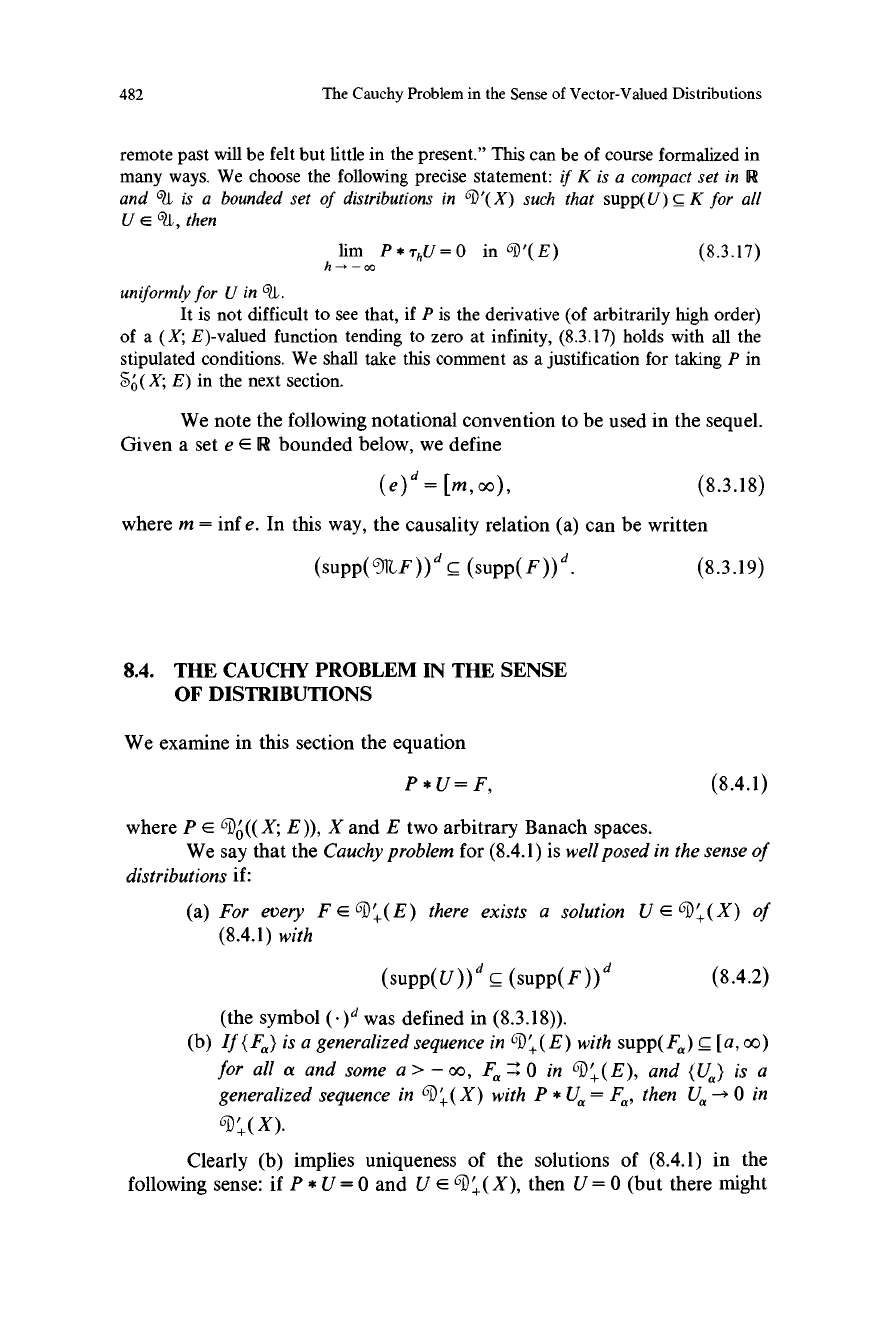
482
The Cauchy Problem in the Sense of Vector-Valued Distributions
remote past will be felt but little in the present." This can be of course formalized in
many ways. We choose the following precise statement: if K is a compact set in R
and Xt is a bounded set of distributions in 6 '(X) such that supp(U) c K for all
U E % , then
lim P * ThU = 0
in 6D'(E)
(8.3.17)
h - oo
uniformly for U in
L.
It is not difficult to see that, if P is the derivative (of arbitrarily high order)
of a (X; E)-valued function tending to zero at infinity, (8.3.17) holds with all the
stipulated conditions. We shall take this comment as a justification for taking P in
S' (X; E) in the next section.
We note the following notational convention to be used in the sequel.
Given a set e e R bounded below, we define
( e )
d
=
[M, 00),
(8.3.18)
where m = inf e. In this way, the causality relation (a) can be written
(supp(OltF))d c (supp(F))d.
(8.3.19)
8.4. THE CAUCHY PROBLEM IN THE SENSE
OF DISTRIBUTIONS
We examine in this section the equation
P * U = F, (8.4.1)
where P E' ' ((X; E)), X and E two arbitrary Banach spaces.
We say that the Cauchy problem for (8.4.1) is well posed in the sense of
distributions if:
(a) For every F E 6 ' (E) there exists a solution U E 6 ;. (X) of
(8.4.1) with
(SUpp(U))d S (supp(F))d
(8.4.2)
(the symbol (.)d was defined in (8.3.18)).
(b) If (Fa) is a generalized sequence in 61 +(E) with supp(Fa) c [a, oo)
for all a and some a > - oo, F,, '_ 0 in
6l. +(E), and (U,,) is a
generalized sequence in 6 +(X) with P * U,, = F.,, then Ua - 0 in
6D, (X).
Clearly (b) implies uniqueness of the solutions of (8.4.1) in the
following sense: if P * U = 0 and U E 6l +(X ), then U = 0 (but there might
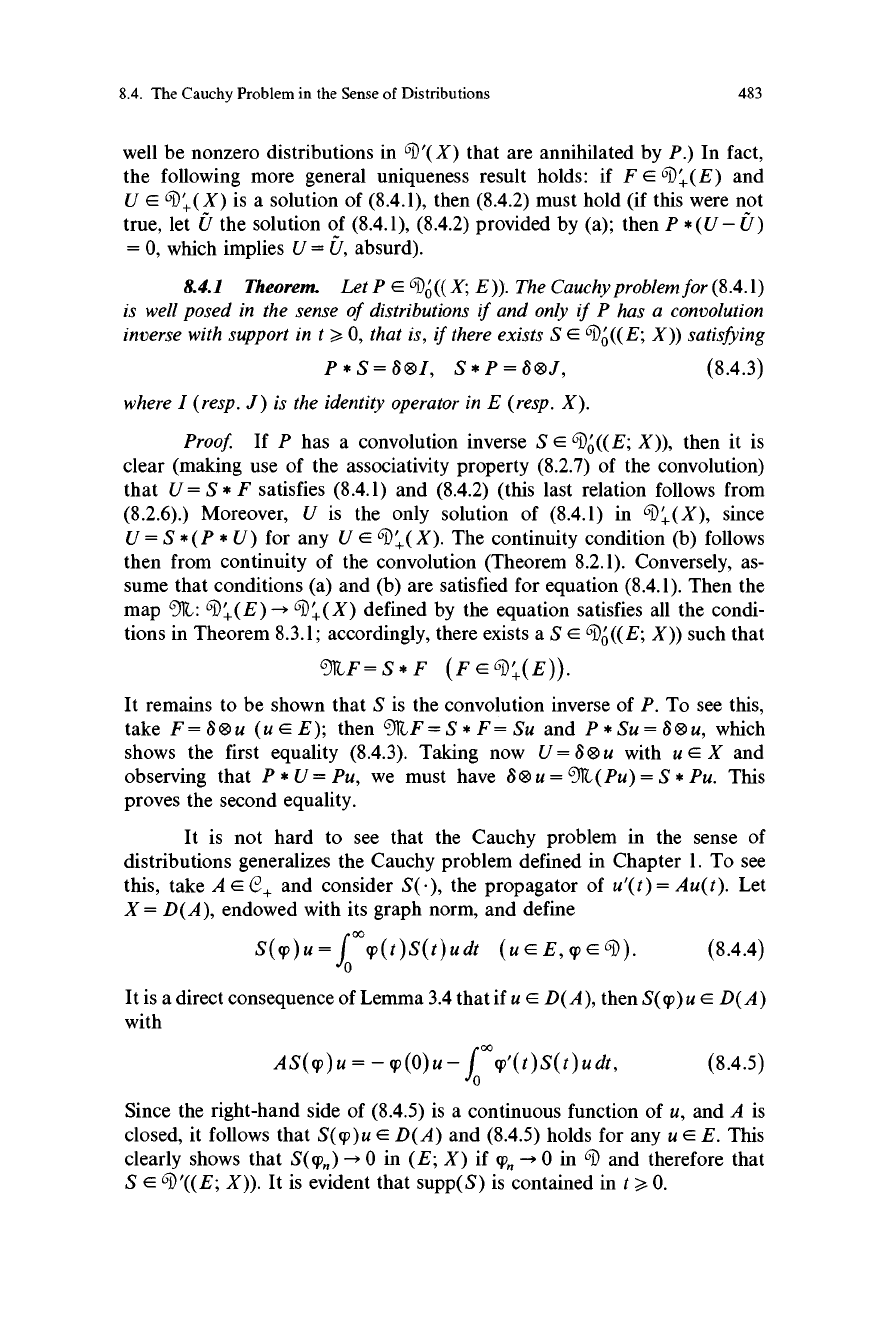
8.4. The Cauchy Problem in the Sense of Distributions
483
well be nonzero distributions in 6 '(X) that are annihilated by P.) In fact,
the following more general uniqueness result holds: if F E 6 +(E) and
U E 6 +(X) is a solution of (8.4.1), then (8.4.2) must hold (if this were not
true, let U the solution of (8.4.1), (8.4.2) provided by (a); then P * (U - U )
= 0, which implies U = U, absurd).
8.4.1 Theorem.
Let P E 6 ' ((X; E)). The Cauchy problem for (8.4. 1)
is well posed in the sense of distributions if and only if P has a convolution
inverse with support in t ? 0, that is, if there exists S E 6 '((E; X)) satisfying
P*S=6®I, S*P=S®J,
(8.4.3)
where I (resp. J) is the identity operator in E (resp. X).
Proof.
If P has a convolution inverse S E 6 ' ((E; X)), then it is
clear (making use of the associativity property (8.2.7) of the convolution)
that U = S * F satisfies (8.4.1) and (8.4.2) (this last relation follows from
(8.2.6).) Moreover, U is the only solution of (8.4.1) in 6D'(X), since
U = S * (P * U) for any U E 6 +(X ). The continuity condition (b) follows
then from continuity of the convolution (Theorem 8.2.1). Conversely, as-
sume that conditions (a) and (b) are satisfied for equation (8.4.1). Then the
map OiL:6 +(E)- 6 +(X) defined by the equation satisfies all the condi-
tions in Theorem 8.3.1; accordingly, there exists a S E'5D ((E; X)) such that
O LF=S*F (Fr=6D (E)).
It remains to be shown that S is the convolution inverse of P. To see this,
take F= S ®u (u E E); then OJii,F = S * F= Su and P* Su = S ®u, which
shows the first equality (8.4.3). Taking now U = S ®u with u E X and
observing that P * U = Pu, we must have S ®u = O 1L (Pu) = S * Pu. This
proves the second equality.
It is not hard to see that the Cauchy problem in the sense of
distributions generalizes the Cauchy problem defined in Chapter 1. To see
this, take A E ('+ and consider S(.), the propagator of u'(t) = Au(t). Let
X = D(A), endowed with its graph norm, and define
S((P)u= f'*(p(t)S(t)udt
(uEE,,VE6D). (8.4.4)
0
It is a direct consequence of Lemma 3.4 that if u E D(A), then S((p)u E D(A)
with
AS(qp)u=-gq(0)u- f orp'(t)S(t)udt,
(8.4.5)
Since the right-hand side of (8.4.5) is a continuous function of u, and A is
closed, it follows that S(q))u E D(A) and (8.4.5) holds for any u E E. This
clearly shows that S(T,,) - 0 in (E; X) if 9?n - 0 in 6D and therefore that
S E 'l. '((E; X)). It is evident that supp(S) is contained in t >, 0.
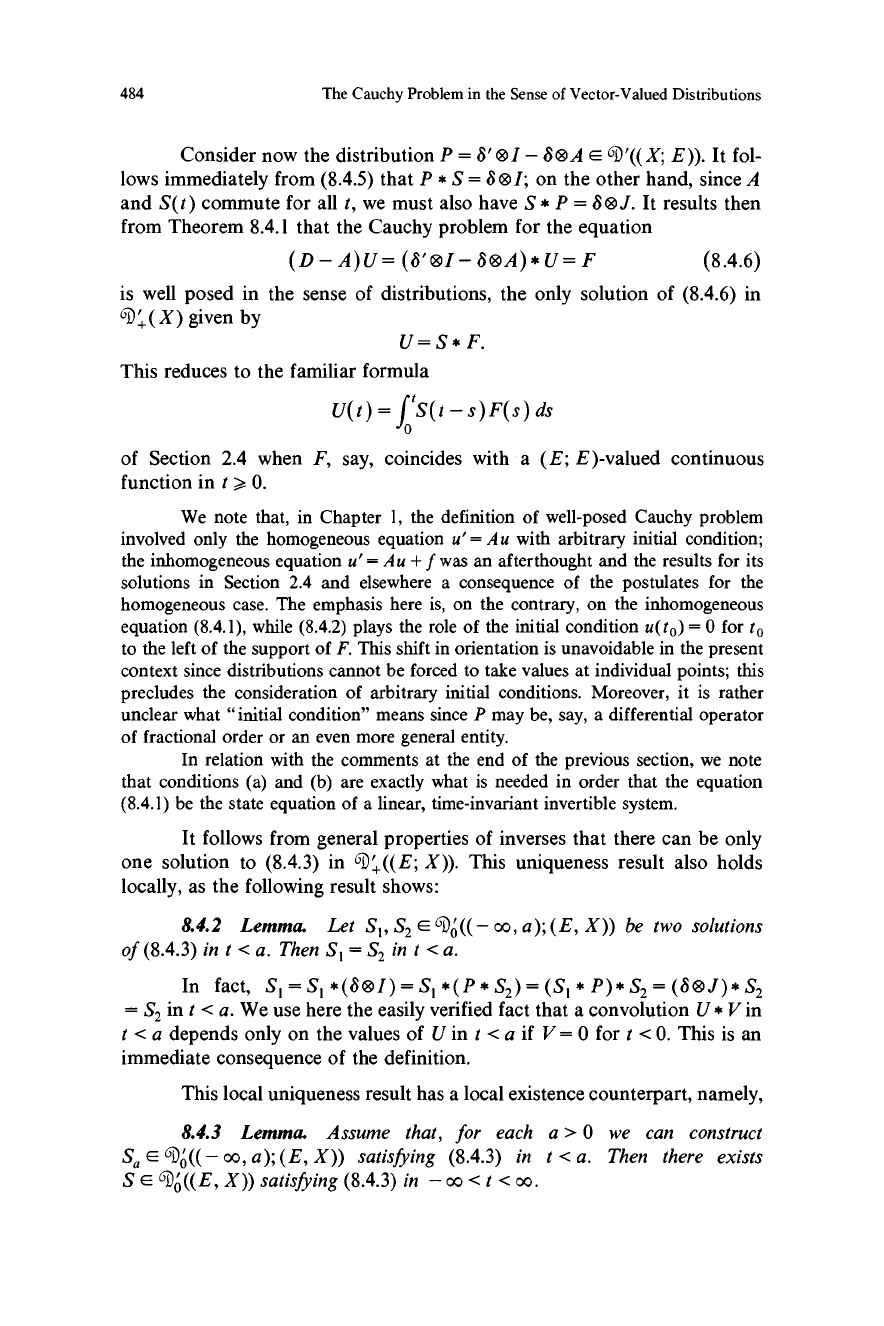
484
The Cauchy Problem in the Sense of Vector-Valued Distributions
Consider now the distribution P = S'®I - S®A E 61.'((X; E)). It fol-
lows immediately from (8.4.5) that P * S = S®I; on the other hand, since A
and S(t) commute for all t, we must also have S * P = S ® J. It results then
from Theorem 8.4.1 that the Cauchy problem for the equation
(D-A)U=(S'®I-S®A)*U=F (8.4.6)
is well posed in the sense of distributions, the only solution of (8.4.6) in
61. +(X) given by
U=S*F.
This reduces to the familiar formula
U(t) = f0`S(t-s)F(s)ds
of Section 2.4 when F, say, coincides with a (E; E)-valued continuous
function in t >_ 0.
We note that, in Chapter 1, the definition of well-posed Cauchy problem
involved only the homogeneous equation u' = Au with arbitrary initial condition;
the inhomogeneous equation u' = Au + f was an afterthought and the results for its
solutions in Section 2.4 and elsewhere a consequence of the postulates for the
homogeneous case. The emphasis here is, on the contrary, on the inhomogeneous
equation (8.4.1), while (8.4.2) plays the role of the initial condition u(to) = 0 for to
to the left of the support of F. This shift in orientation is unavoidable in the present
context since distributions cannot be forced to take values at individual points; this
precludes the consideration of arbitrary initial conditions. Moreover, it is rather
unclear what "initial condition" means since P may be, say, a differential operator
of fractional order or an even more general entity.
In relation with the comments at the end of the previous section, we note
that conditions (a) and (b) are exactly what is needed in order that the equation
(8.4.1) be the state equation of a linear, time-invariant invertible system.
It follows from general properties of inverses that there can be only
one solution to (8.4.3) in 61.+((E; X)). This uniqueness result also holds
locally, as the following result shows:
8.4.2
Lemma. Let S,, S2 E 6D ((- oo, a); (E, X)) be two solutions
of (8.4.3) in t < a. Then S, = S2 in t < a.
In fact, S,=S,*(S®I)=S,*(P*S2)=(S,*P)*S2=(S(&J)*S2
= S2 in t < a. We use here the easily verified fact that a convolution U * V in
t < a depends only on the values of U in t < a if V = 0 for t < 0. This is an
immediate consequence of the definition.
This local uniqueness result has a local existence counterpart, namely,
8.4.3 Lemma. Assume that, for each a> 0 we can construct
Su E 610 ((- oo, a); (E, X)) satisfying (8.4.3) in t < a. Then there exists
S E 6D' ((E, X)) satisfying (8.4.3) in - oo < t < oo.
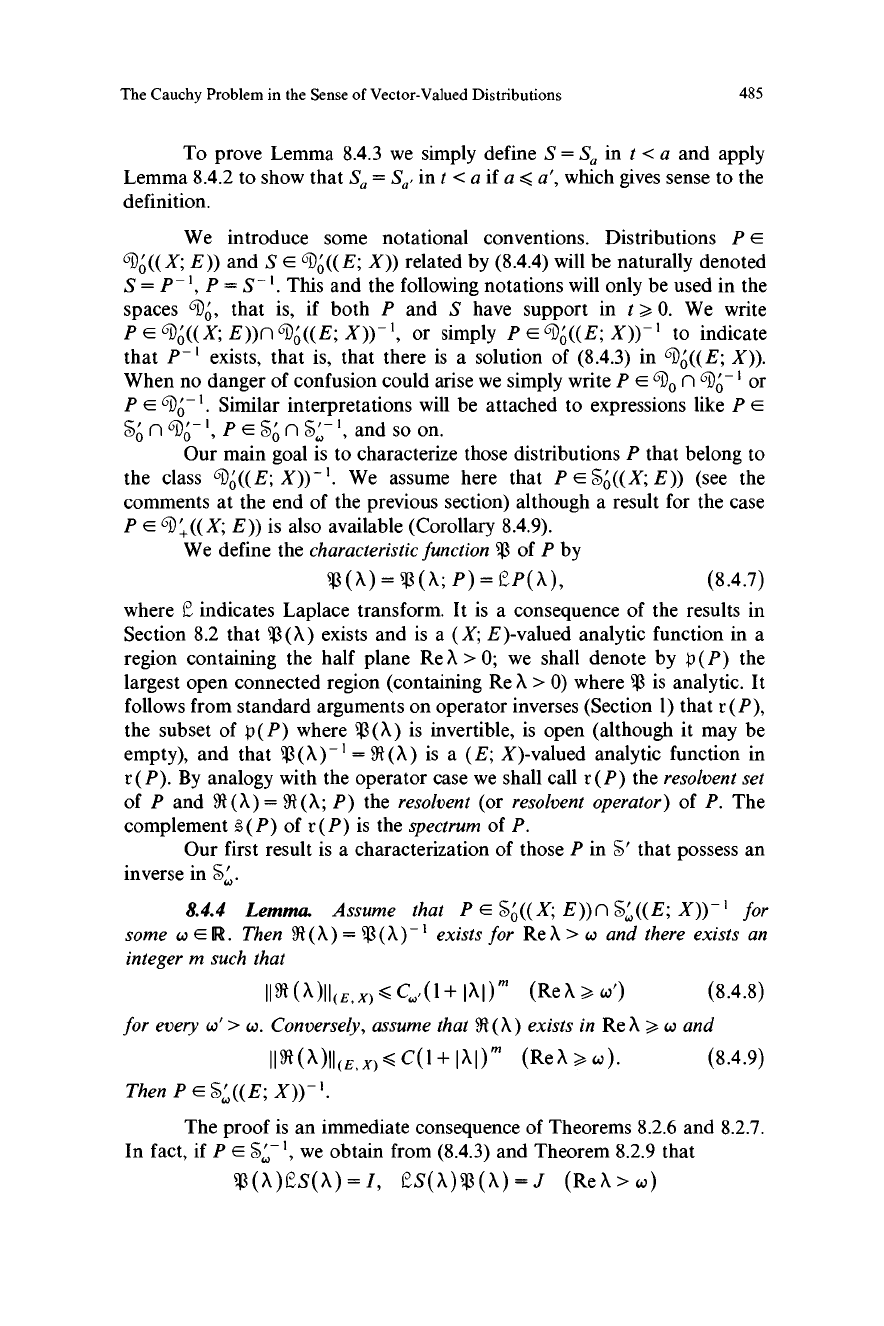
The Cauchy Problem in the Sense of Vector-Valued Distributions
485
To prove Lemma 8.4.3 we simply define S = Sa in t < a and apply
Lemma 8.4.2 to show that Su = Sa, in t < a if a < a', which gives sense to the
definition.
We introduce some notational conventions. Distributions P E
6l. ' ((X; E)) and S E 6l ' ((E; X)) related by (8.4.4) will be naturally denoted
S = P', P = S'. This and the following notations will only be used in the
spaces 6D', that is, if both P and S have support in t , 0. We write
P E 6 ' ((X; E )) n 6D' ((E; X))-', or simply P E 6D' ((E; X))-' to indicate
that P-' exists, that is, that there is a solution of (8.4.3) in 6D ((E; X)).
When no danger of confusion could arise we simply write P E 6l o n 6D o
' or
P E 6D'-'. Similar interpretations will be attached to expressions like P E
,50 1 n 6D,- 1, P E 50 1 n 51 - ', and so on.
Our main goal is to characterize those distributions P that belong to
the class 6l,0'((E; X)) -'. We assume here that P E 5'((X; E)) (see the
comments at the end of the previous section) although a result for the case
P E 6 +((X; E)) is also available (Corollary 8.4.9).
We define the characteristic function q3 of P by
13 (X)=$(X;P)=EP(X),
(8.4.7)
where L indicates Laplace transform. It is a consequence of the results in
Section 8.2 that q3 (X) exists and is a (X; E )-valued analytic function in a
region containing the half plane Re X > 0; we shall denote by p (P) the
largest open connected region (containing Re X > 0) where $ is analytic. It
follows from standard arguments on operator inverses (Section 1) that r(P),
the subset of P (P) where $ (X) is invertible, is open (although it may be
empty), and that $ (X) -' = t (X) is a (E; X)-valued analytic function in
r (P). By analogy with the operator case we shall call r (P) the resolvent set
of P and 91 (X) = R (X; P) the resolvent (or resolvent operator) of P. The
complement (P) of r (P) is the spectrum of P.
Our first result is a characterization of those P in "' that possess an
inverse in 5w.
8.4.4
Lemma. Assume that P E S' ((X; E )) n Sw (E; X)) -' for
some w E R. Then 91 (X) (X)
exists for Re X > w and there exists an
integer m such that
1191 (X)ll(E,x) <C,,,(1+IX1)m (ReX,w')
(8.4.8)
for every to' > w. Conversely, assume that 32 (X) exists in Re X , w and
II91(X)ll(E,x). C(l+lXl)t (ReX,w). (8.4.9)
Then P E S' ((E; X))-'.
The proof is an immediate consequence of Theorems 8.2.6 and 8.2.7.
In fact, if P E S' we obtain from (8.4.3) and Theorem 8.2.9 that
$(X)cS(X)=I, ES(X)j3(X)=J (ReX>w)

486
The Cauchy Problem in the Sense of Vector-Valued Distributions
so that R (A) = LS(A) and Theorem 8.2.6 applies. On the other hand,
assume that (8.4.9) holds. Then it follows from Theorem 8.1.7 that
3t(A)=eS(A) (ReA>w),
where S is a distribution in 5W '((E; X)). Then ,(P * S)(A) = 3(A)ES(X) _
I, L (S * P)(A) = -P-S(X) 1(A) = J, thus both equalities 8.4.3 follow from
uniqueness of the Laplace transform (see the end of the proof of Theorem
8.2.7).
8.4.5 Example.
Let A be a closed operator in E with domain D(A). We
consider the equation
(D-A)U=F. (8.4.10)
Here X=D(A) (endowed with the graph norm IIuIIx = IIuII+IIAuII) and
P = S' ®I - S ®A. Clearly $(A) = A I - A (so that P(P)=C). According to
our general definition r (R) consists of all those A such that Al - A (as an
operator from X=D(A) into E) has a bounded inverse 91(X). Since
IIu11,<11u11x(uEX),it follows that 9t(A)E(E,E)and
1191(X)II(E,E)1< 119'(X)11(E,X)-
(8.4.11)
On the other hand, assume that 91(A) _ (X I - A) -' E (E, E ). Then, since
A9(A) = A9t(A)- I, it is clear that 3t (X) E (E; X) as well and
1191(A)ll(E,x)<1+(I+I XI)119l(X)11(E,E)
(8.4.12)
It follows that r(P)=p(A) and that 31(X; P) = R (A; A); moreover, in-
equalities (8.4.8) or (8.4.9) will hold in the norm of (E, X) if and only if
they hold (with a different integer m) in the norm of (E, E).
8.4.6 Example. We take now two closed operators A, B with domains
D(A) and D(B) and X= D(A)n D(B) endowed with the "joint graph
norm"
Ilullx = IIull+IIAull+IIBu11.
It is easy to see that 11' II
x
makes X a Banach space. We consider the
equation
(D2-BD-A)U=F. (8.4.13)
Here P=S"®I-S'®B-6®A, p(P)=C, $(X)=AzI-AB-A, r(P) is
the set of all A for which A2I - X B - A has an inverse 91(X) bounded as an
operator from E into X. Clearly (8.4.11) holds as well now; on the other
hand, if 591(X) = (AZI - AB - A)-' exists and belongs to (E, E) together
with A91(A), we obtain from the equality B91(A)=X91(A)-A-'A31(A)-
A X- 'that
II9(A)ll(E,x)1< IXI-'+('+ IAI)II91(A)ll(E,E)+(1+ IXI-')IIA91(A)ll(E,E).
(8.4.14)
